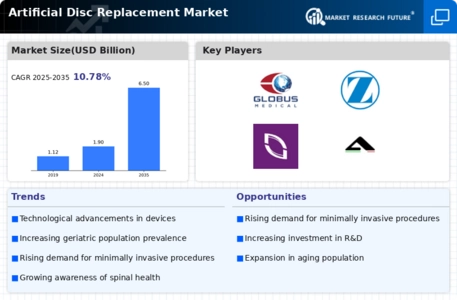Market Growth Projections
The Global Artificial Disc Replacement Market Industry is poised for substantial growth, with projections indicating a rise from 1.9 USD Billion in 2024 to 6.5 USD Billion by 2035. This growth trajectory reflects a compound annual growth rate (CAGR) of 11.83% from 2025 to 2035. Factors contributing to this growth include technological advancements, increasing healthcare expenditures, and a rising prevalence of spinal disorders. The market's expansion is likely to be supported by ongoing research and development efforts aimed at improving artificial disc designs and surgical techniques, ensuring that the industry remains at the forefront of spinal healthcare.
Increasing Healthcare Expenditure
The Global Artificial Disc Replacement Market Industry is benefiting from rising healthcare expenditures across various regions. Governments and private sectors are investing more in healthcare infrastructure, which includes advanced surgical procedures and technologies. This trend is particularly evident in developed countries, where healthcare budgets are expanding to accommodate innovative treatments. As a result, the market is likely to witness a compound annual growth rate (CAGR) of 11.83% from 2025 to 2035. Increased funding for healthcare initiatives allows for better access to artificial disc replacement surgeries, thereby enhancing patient outcomes and overall market growth.
Rising Prevalence of Spine Disorders
The Global Artificial Disc Replacement Market Industry is experiencing growth due to the increasing prevalence of spine disorders, such as degenerative disc disease and herniated discs. As populations age, the incidence of these conditions rises, leading to a higher demand for effective treatment options. In 2024, the market is projected to reach 1.9 USD Billion, driven by advancements in surgical techniques and the growing acceptance of artificial disc replacement as a viable alternative to traditional spinal fusion. This trend suggests that healthcare providers are increasingly recognizing the benefits of artificial discs in improving patient outcomes and reducing recovery times.
Technological Advancements in Disc Replacement
Technological innovations play a crucial role in the expansion of the Global Artificial Disc Replacement Market Industry. The development of next-generation artificial discs, which offer enhanced biomechanical properties and improved compatibility with human anatomy, has the potential to revolutionize treatment options. These advancements not only improve surgical outcomes but also increase patient satisfaction. As a result, the market is expected to grow significantly, with projections indicating a rise to 6.5 USD Billion by 2035. The integration of minimally invasive surgical techniques further supports this growth, as they reduce hospital stays and recovery times, making artificial disc replacement more appealing to both patients and healthcare providers.
Aging Population and Demand for Surgical Solutions
The aging global population is a key driver of the Global Artificial Disc Replacement Market Industry. As individuals age, they become more susceptible to spinal disorders, leading to an increased demand for surgical interventions. The demographic shift towards an older population necessitates innovative solutions such as artificial disc replacement, which offers a less invasive alternative to traditional methods. This trend is expected to propel the market to 1.9 USD Billion in 2024, with a sustained growth trajectory as the population continues to age. The demand for effective and efficient surgical solutions will likely remain a priority for healthcare systems worldwide.
Growing Awareness and Acceptance of Artificial Disc Replacement
There is a notable increase in awareness and acceptance of artificial disc replacement among both healthcare professionals and patients, significantly impacting the Global Artificial Disc Replacement Market Industry. Educational initiatives and outreach programs are helping to inform patients about the benefits of artificial discs compared to traditional spinal fusion. This growing awareness is likely to drive demand, as patients seek less invasive options with quicker recovery times. Furthermore, as more successful case studies emerge, the acceptance of artificial disc replacement is expected to rise, contributing to the market's projected growth to 6.5 USD Billion by 2035.








Leave a Comment